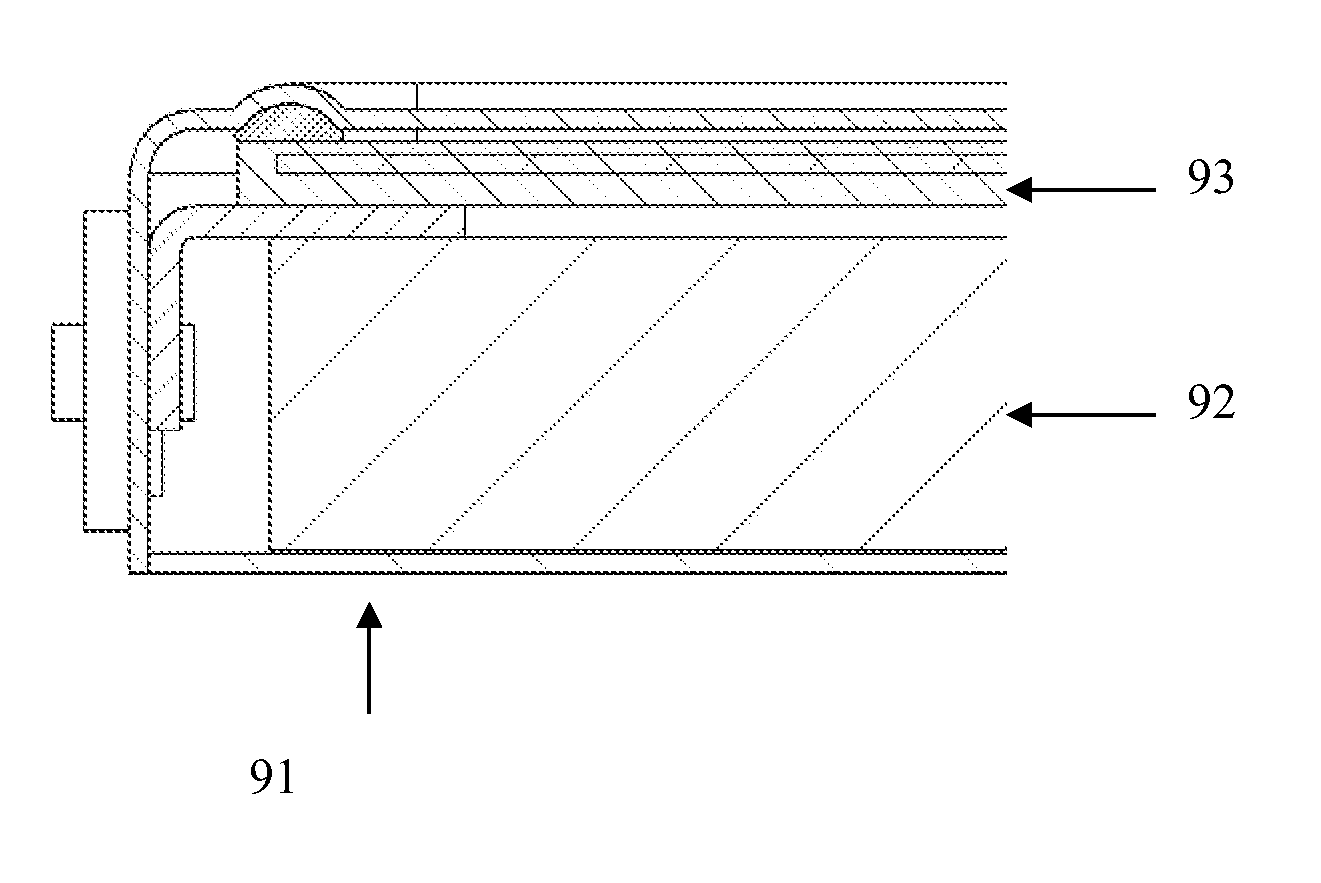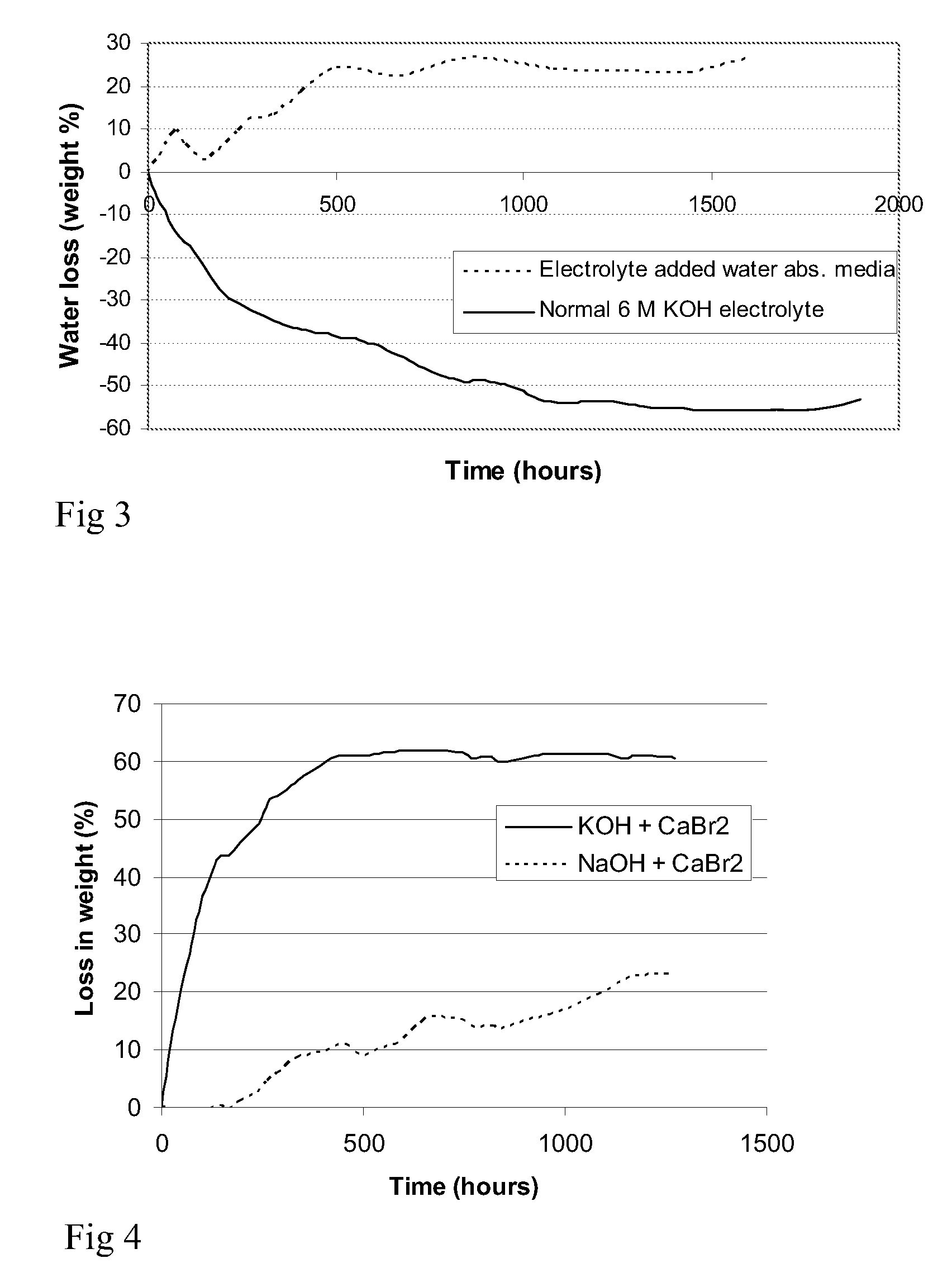Metal-Air Battery or Fuel Cell
a fuel cell and metal air technology, applied in the direction of aqueous electrolyte fuel cells, cell components, electrochemical generators, etc., can solve the problems of increasing ohmic resistance, increasing volumetric energy density and the need for size-consuming peripheral systems, and many major challenges still faced, so as to prevent flooding or drying out, improve conductivity, and stabilize the
- Summary
- Abstract
- Description
- Claims
- Application Information
AI Technical Summary
Benefits of technology
Problems solved by technology
Method used
Image
Examples
example 1
[0094] The water retaining properties were tested for the following hygroscopic salts: CH3COOK, K2CO3 and CaBr2. 1.000 g of each of the three powders was weighed out and placed in open glass containers. The samples were left at ambient conditions and weight measurements were performed once a day. The humidity and temperature were logged continuously. After 1-3 days it was observed that the powder slowly turned into a liquid as water was absorbed. The ability of the different powders to absorb water from the atmosphere is shown in FIG. 1. The curves show the increase in weight as a function of time for each of the powders. It was observed that CaBr2 absorbed water from the atmosphere, and after two days the powder was completely dissolved in water. The increase in weight was almost 50%. A similar result was obtained with CH3COOK and K2CO3, but it takes 10 days to have a similar increase in weight.
[0095] The example shows the amount of water absorbed into the hygroscopic powders. The...
example 2
Comparison
[0096] In the experiment two prismatic batteries with different alkaline electrolytes, NaOH and KOH, were studied. The anode of each cell was prepared with 6 g of Zn, 0.15 g of Carbopol 940 (Noveon), 0.15 g of PTFE powder with a particle size of 1 mm (Lawrence Industries) and 0.5 g of CaBr2. The paste was made with the different electrolytes, and the polypropylene separator membrane was also soaked in each electrolyte. On top of the anode and separator an air electrode created according to assembly example 2 in the detailed description of the invention was added. The battery assembly is illustrated in FIG. 9 and described above. The cells were not completely sealed, with openings for the current collectors. The experiment was performed at ambient temperature and humidity.
[0097] The OCP was registered regularly for two days as shown in FIG. 2. Measurements of the OCP indicate an active electrode well wetted with the electrolyte.
[0098] It was observed that the cell with N...
example 3
[0100] By adding a hygroscopic material to the electrolyte, the loss of water within the battery is reduced. A dry sample of 20% NaOH and 80% CaBr2, 6 grams in total, was left in ambient air for about 1600 hours. As reference a sample of 30 g KOH solution (6 M) was used. Both samples were weighed regularly during the experiment. The percentage change in weight for the two samples is shown in FIG. 3 as a function of time. For the powder mixture of NaOH and CaBr2 an increase in weight with time due to absorption of water from the air is shown. After about 1000 hours, however, the weight stabilises. This indicates that the powder is saturated with water and is in balance with the surroundings. For the KOH sample without any hygroscopic material, a decrease in weight through the complete period due to evaporation of water is shown.
[0101] The example shows that the cell with aqueous KOH dries out with time. The example also shows that the weight of the CaBr2 and NaOH mixture remains sta...
PUM
| Property | Measurement | Unit |
|---|---|---|
| Molar density | aaaaa | aaaaa |
| Hygroscopicity | aaaaa | aaaaa |
| Weight ratio | aaaaa | aaaaa |
Abstract
Description
Claims
Application Information
 Login to View More
Login to View More - R&D
- Intellectual Property
- Life Sciences
- Materials
- Tech Scout
- Unparalleled Data Quality
- Higher Quality Content
- 60% Fewer Hallucinations
Browse by: Latest US Patents, China's latest patents, Technical Efficacy Thesaurus, Application Domain, Technology Topic, Popular Technical Reports.
© 2025 PatSnap. All rights reserved.Legal|Privacy policy|Modern Slavery Act Transparency Statement|Sitemap|About US| Contact US: help@patsnap.com



